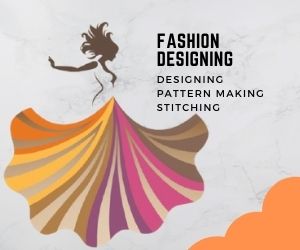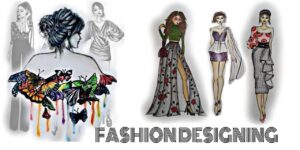Fashion design
Fashion design is the art of applying design, aesthetics, clothing construction and natural beauty to clothing and its accessories. It is influenced by culture and different trends, and has varied over time and place. “A fashion designer creates clothing, including dresses, suits, pants, and skirts, and accessories like shoes and handbags, for consumers. He or she can specialize in clothing, accessory, or jewelry design, or may work in more than one of these areas.
Fashion design is a form of art dedicated to the creation of clothing and other lifestyle accessories. Modern fashion design is divided into two basic categories: haute couture and ready-to-wear. The haute couture collection is dedicated to certain customers and is custom sized to fit these customers exactly. In order to qualify as a haute couture house, a designer has to be part of the Syndical Chamber for Haute Couture and show a new collection twice a year presenting a minimum of 35 different outfits each time.
Ready-to-wear collections are standard sized, not custom made, so they are more suitable for large production runs. They are also split into two categories: designer/createur and confection collections. Designer collections have a higher quality and finish as well as an unique design. They often represent a certain philosophy and are created to make a statement rather than for sale. Both ready-to-wear and haute-couture collections are presented on international catwalks.
About the fashion designers
Fashion designers work in a variety of different ways in designing their pieces and accessories such as rings, bracelets and necklaces. Because of the time required to bring a garment onto the market, designers must at times anticipate changes to consumer desires.
Education
To become a fashion designer there is training and certifications that will help you succeed in this profession. However, you don’t need a college degree, although it would help you become more successful. An associates or bachelors degree in fashion design would aid in this success. “As a fashion design major, you will take classes in color, textiles, sewing and tailoring, pattern making, fashion history, and computer-aided design (CAD) and learn about different types of clothing such as menswear or footwear ” .[4] By receiving education will help new fashion designers understand every important detail in fashion and designing clothes and footwear. Al
Fashion designers work in different ways. Some sketch their ideas on paper, while others drape fabric on a dress form, another term for mannequine. When a designer is completely satisfied with the fit of the toile (or muslin), he or she will consult a professional pattern maker who then makes the finished, working version of the pattern out of card or via a computerized system. Finally, a sample garment is made up and tested on a model to make sure it is an operational outfit.
History
Most fashion houses in the United States are based in New York City, with a high concentration centered in the Garment District neighborhood. On the US west coast, there is also a significant number of fashion houses in Los Angeles, where a substantial percentage of high fashion clothing manufactured in the United States is actually made. Beverly Hills, particularly on Rodeo Drive, is globally renowned for its fashion design and prestigious shopping. Burgeoning industries in Miami, Chicago, Dallas, and especially San Francisco have developed as well. A semi-annual event held every February and September, New York Fashion Week, is the oldest of the four major fashion weeks held throughout the world. Parsons The New School for Design, located in the Greenwich Village neighborhood of Lower Manhattan in New York City, is considered one of the top fashion schools in the world. There are numerous fashion magazines published in the United States and distributed to a global readership. Examples include Vogue, Harper’s Bazaar, and Cosmopolitan.
Designer Clothes
There are many different genres of designer clothing that cater for a multitude of markets. Some people like chic and trendy, whilst others like loud and bold clothing designs. Designer clothing is about the individuals taste and it is important to wear clothes that you feel comfortable in. By wearing designer clothes you can increase your confidence which is important in interacting in today’s society. Designer clothing also comes in many shapes and sizes so you don’t have to have the perfect figure to wear the latest designs. Designer clothing is even available in maternity sizes. This is vital for the modern mum who wants to continue to look good through her pregnancy.
Looking good in front of your peers is easily achieved by wearing designer clothing. As designer clothes are a sought after item, by wearing them you will improve your social status within your group of friends. Achieving a modern look with designer clothing can be accomplished without breaking the bank it you shop wisely. There are many designer clothing items at a reduced price available on the internet. The internet prices are cheaper because the designer clothing retailer’s overheads are lower, not because the designer clothes are fakes, of lesser quality or damaged items.
Types of fashion
Garments produced by clothing manufacturers fall into three main categories, although these may be split up into additional, more specific categories
Haute couture
Until the 1950s, fashion clothing was predominately designed and manufactured on a made-to-measure or haute couture basis (French for high-sewing), with each garment being created for a specific client. A couture garment is made to order for an individual customer, and is usually made from high-quality, expensive fabric, sewn with extreme attention to detail and finish, often using time-consuming, hand-executed techniques. Look and fit take priority over the cost of materials and the time it takes to make. Due to the high cost of each garment, haute couture makes little direct profit for the fashion houses, but is important for prestige and publicity.
Ready-to-wear (prêt-à-porter)
Ready-to-wear, or prêt-à-porter, clothes are a cross between haute couture and mass market. They are not made for individual customers, but great care is taken in the choice and cut of the fabric. Clothes are made in small quantities to guarantee exclusivity, so they are rather expensive. Ready-to-wear collections are usually presented by fashion houses each season during a period known as fashion week This takes place on a citywide basis and occurs twice a year. The main seasons of Fashion Week include: spring/summer, fall/winter, resort, swim, and bridal.
Half-way garments are an alternative to ready-to-wear, “off-the-peg”, or prêt-à-porter fashion. Half-way garments are intentionally unfinished pieces of clothing that encourages co-design between the “primary designer” of the garment, and what would usually be considered, the passive “consumer” This differs from ready-to-wear fashion, as the consumer is able to participate in the process of making and co-designing their clothing. During the Make{able} workshop, Hirscher and Niinimaki found that personal involvement in the garment-making process created a meaningful “narrative” for the user, which established a person-product attachment and increased the sentimental value of the final product.
Otto von Busch also explores half-way garments and fashion co-design in his thesis, “Fashion-able, Hacktivism and engaged Fashion Design”.
Mass market
Currently, the fashion industry relies more on mass-market sales. The mass market caters for a wide range of customers, producing ready-to-wear garments using trends set by the famous names in fashion. They often wait around a season to make sure a style is going to catch on before producing their versions of the original look. To save money and time, they use cheaper fabrics and simpler production techniques which can easily be done by machines. The end product can, therefore, be sold much more cheaply.
There is a type of design called “kutch” originated from the German word kitschig, meaning “trashy” or “not aesthetically pleasing”. Kitsch can also refer to “wearing or displaying something that is therefore no longer in fashion”.
Income
Median annual wages for salaried fashion designers were $61,160 in May 2008. The middle 50 percent earned between $42,150 and $87,120.[15] The lowest 10 percent earned less than $32,150, and the highest 10 percent earned more than $124,780. Median annual earnings were $52,860 (£40,730.47) in apparel, piece goods, and notions – the industry employing the largest numbers of fashion designers.[16] As of 2016,a fashion designer’s median annual salary was $65,170. High end designers can earn around $92,550. In 2016, 23,800 people were counted as fashion designers in the United States.



